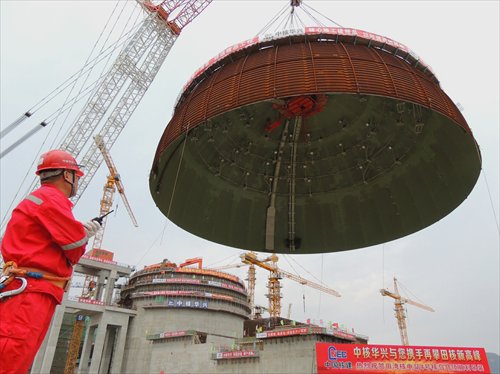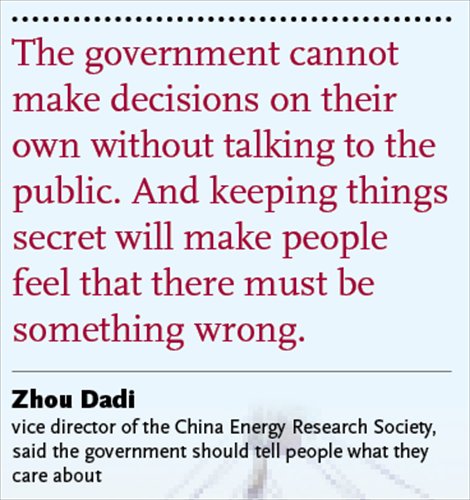Govt officials try to quell nuclear power worries, but fears persist
China is aiming to have more than 110 nuclear power plants by 2030, more than the US. Under this drive, many are advocating that construction work on inland nuclear power plants, which was suspended after the 2011 Fukushima disaster in Japan, should be restarted. However, public fear of nuclear accidents persists.

Workers put a dome in place at the Tianwan Nuclear Power Plant in Lianyungang, Jiangsu Province, on September 26, 2015. Photo: CFP
If one drives down the highway into the mountainous region of Taohuajiang in Yiyang, Central China's Hunan Province, one will come across a humble plant, surrounded by water sitting tucked away amidst the peaks.
The patch of former farmland was taken over by the China National Nuclear Power Corporation (CNNPC) several years ago to build China's first inland nuclear power plant.
While the billions of yuan planned for this project has given it advanced technology to work with, since it started about a decade ago it has not generated a single spark.
Every time Xia Weibing, a local, passes by and sees the site, he wonders when they will resume work on it. "It's a good thing if it poses no safety risks," he said.
"They have finished the preliminary works there, including building the highway, which used to be a dirt road. I think they won't just leave it this way," said Xia.
In the aftermath of the 2011 Fukushima Daiichi nuclear disaster in Japan, the Chinese government slowed its work on nuclear power plants and Taohuajiang's construction came to a full stop. But given the government's plans to expand "clean" energy sources and its pledge to peak CO2 emissions by 2030, nuclear power seems alluring again.
"According to the 13th Five-year Plan which aims to build an expected capacity of 58 million kilowatts by 2020, we need to build several nuclear power plants each year and it's a heavy workload. Work on suspended inland power plants, including Taohuajiang, should be resumed," said Zhou Dadi, vice director of the China Energy Research Society.
In March's national two legislative sessions, members from the Hunan delegation proposed the plant's construction be resumed this year. Also in March, local officials and the Taohuajiang plant manager set up a "group" to promote the plant, though how they will do this remains unclear. Meanwhile, the CNNPC is trying to dispel locals' fear about the plant by holding "educational" activities.
Despite governments' and companies' efforts to soothe the public's fear, many ordinary citizens do not want nuclear plants built near their communities, fearful of potential accidents and nuclear leaks.

Mixed opinions
In February, a 3.2-magnitude earthquake hit Taohuajiang. Liu Zhipeng, whose hometown is less than 10 kilometers away from the first phase of the plant site, says this is good news. "The construction of the plant may be stopped forever because of the earthquake," he said.
Later the Ministry of Environmental Protection said that the earthquake will not influence the plant.
There are more than 1,000 members of Liu's clan living in the area. "I don't worry about myself. I am concerned the plant will have a bad influence on future generations. I can't imagine what will happen to our land and people once nuclear leaks happen," he said.
Liu has a friend whose land was taken to build the power plant and he was promised a sum of money as compensation. "Last time I saw him, he said that he did not get the full compensation as the construction has slowed. I don't know what's going on with him now."
The WeChat account of Hunan Taohuajiang Nuclear Power Corporation (HTNPC) posted an article on April 13 which described the visit of local environmental NGO Green Hunan to visit the site, implying that the environmentalists and the nuclear power firm have the same goal.
However, a Green Hunan staff member told the Global Times that "the article doesn't represent our attitude. We have asked them to remove it." She declined to make any further comment on the nuclear power issue.
According to an article published in China Economic Weekly, several locals living near the suspended Xiaomoshan nuclear plant in Hunan said as long as the government compensates them properly for any land that is seized, they don't care about the plant. They said they don't worry about nuclear security, admitting that they know nothing about the potential risks.
Zhou said that he has been to several nuclear power plant sites in rural regions. The locals told him that they are welcoming the plants because they will help boost local economy.
"Different people have different opinions about the nuclear power plant. There can't be unification," said Zhang Qiaoyan, who used to be a middle school teacher in Cangnan township, East China's Zhejiang Province, future home of the San'ao Nuclear Power Plant.
Zhang first got to know about the San'ao plant through her student who posted articles about it on WeChat. The student, according to Zhang, went to Shanghai but couldn't find a good job. She later secured a job writing publicity pieces for the San'ao plant. "She is happy about it and thinks it's a good thing," Zhang said.
"But for me, a naturalist, this is a disaster. It's hard to imagine how the landscape is going to be ruined due to the nuclear power plant," she added.
Reaching the public
The Taohuajiang nuclear project kicked off in May 2006. An e-mail sent by the CNNPC to the Global Times said that the company insists "on the transparency of information" and has tried to reach out to residents through PR and public forums.
They have invited locals to visit the plant site, have conducted surveys of resident's attitudes and organized local government officials to study nuclear power.
"We insist on transparent communication and operations to reassure the public and enhance general confidence toward nuclear power," read the e-mail.
Like Taohuajiang, the local government has tried to prepare its citizens for the San'ao Nuclear Power Plant.
All of China's currently operating nuclear power plants are coastal, as nuclear plants need lots of water to act as coolant for their reactors. Unlike Taohuajiang, which has faced doubts due to it being an inland plant, coastal San'ao's construction has been relatively smooth. The plant is now waiting for an environmental assessment.
According to local news site cnxw.com.cn, a special group set by the Cangnan township government went to San'ao village to meet with some of the about 700 households that will be directly affected by the plant.
"Now this place is just a village, but later it will be developed into a township. You will become townspeople. Life will become better," Huang Rongding, the head of Cangnan told the villagers.
"The government cannot make decisions on their own without talking to the public. And keeping things secret will make people feel that there must be something wrong," Zhou said, noting that in the Japanese nuclear plants he has been to, they build a club by the plant and invite children to tour the premises. They can learn about nuclear power and get a look at the whole environment. "Seeing is believing," he stressed.
But Zhou suggested that it's better not to explain every detail of nuclear power to the public. "Nuclear knowledge is too sophisticated for ordinary people. Explaining too many scientific things will make them exhausted. We should only tell them what they care about," he said.
Opportunities or devils?
About 11 percent of global electricity is generated by nuclear plants. In Europe, this proportion is more than 20 percent, while in China it's only about 3 percent, according to Zhou.
Beijing-based China Times reported that China will operate more than 110 nuclear power plants by 2030, exceeding the total number of US plants. The country plans to build six to eight nuclear power plants in the next five years.
"It's a great opportunity for nuclear power development. This will help with energy restructuring. We now depend too much on coal. Also, in many inland places, there is a lack of coal, gas or water. To develop nuclear power is a good choice," said Zhou, adding that after accidents happened around the world, safety awareness and nuclear technology have been simultaneously improved.
While Zhou said that inland nuclear plants aren't more dangerous than coastal ones, Wang Yinan, a researcher with the Development Research Center of the State Council, is strongly against these plans.
Wang pointed out that the dense population along the Yangtze River and the uncertainty of nuclear power plants could cause serious risks.
"Nuclear power is low-carbon energy, not clean energy. Once it leaks, it becomes the most formidable source of pollution to deal with. No chemical or physical methods can eliminate the long-lasting and highly radioactive nuclide," she said.
She added that the development of nuclear power should be based on careful deliberation of how to deal with nuclear waste and also how to handle plants once they are retired.
"Besides, we need to consider nuclear security, not just nuclear safety. It's necessary to consider terrorist attacks, cyber attacks and intentional sabotage into consideration when assessing the security of inland nuclear power," she said.
Zhou stressed that the division of opinions inside academic circles makes people confused. "Some scholars who are against nuclear power are making loud voices in media and society. This confuses people."
Newspaper headline: Plutonium PR